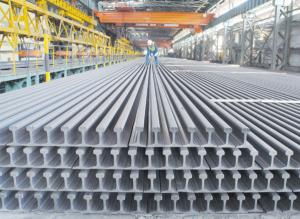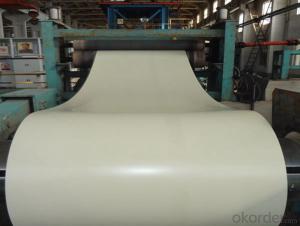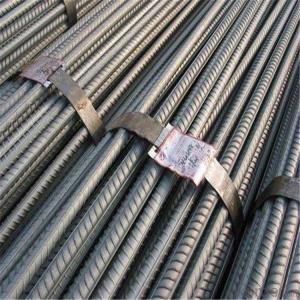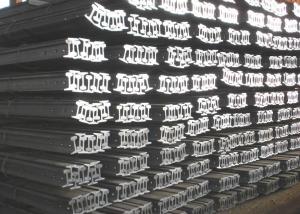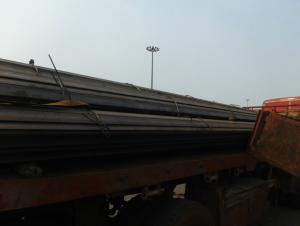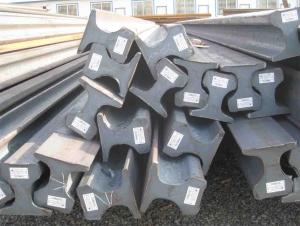Steel Light Rail wfith High Quality for Construction
- Loading Port:
- China main port
- Payment Terms:
- TT or LC
- Min Order Qty:
- 25 m.t.
- Supply Capability:
- 100000 m.t./month
OKorder Service Pledge
OKorder Financial Service
You Might Also Like
Specifications of Steel Light Rail wfith High Quality for Construction:
Production Standard: GB11264-89
Material: Q235, 55Q
Grade | Element(%) | ||||
C | Mn | S | P | Si | |
Q235 | 0.12—0.20 | 0.3—0.7 | ≤0.045 | ≤0.045 | ≤0.3 |
55Q | 0.50—0.60 | 0.70—1.00 | ≤0.050 | ≤0.045 | 0.15-0.35 |
Sizes: 9kg, 12kg, 15kg, 22kg, 30kg
Length: 6M, 8M, 10M, 12M or as the requriement
Invoicing on theoretical weight or actual weight as customer request
Payment terms: 30% advance payment by T/T, 70% payment against the copy of the B/L; 100% L/C at sight, etc.
Applications of Steel Light Rail wfith High Quality for Construction:
Light Steel Rail is mainly used in forest region, mines, factories and construction sites laid of the place such as temporary transport line and light motorcycles with line, for example:
railway, subway, transportation track, express, curve way, tunnel way.
Package & Delivery of Steel Light Rail wfith High Quality for Construction:
1. Package: it is nude packed in bundles by steel wire rod
2. Bundle weight: not more than 3.5MT for bulk vessel; less than 3 MT for container load
3. Marks:
Color marking: There will be color marking on both end of the bundle for the cargo delivered by bulk vessel. That makes it easily to distinguish at the destination port.
Tag mark: there will be tag mark tied up on the bundles. The information usually including supplier logo and name, product name, made in China, shipping marks and other information request by the customer.
If loading by container the marking is not needed, but we will prepare it as customer request.
4. Transportation: the goods are delivered by truck from mill to loading port, the maximum quantity can be loaded is around 40MTs by each truck. If the order quantity cannot reach the full truck loaded, the transportation cost per ton will be little higher than full load.
5. Delivered by container or bulk vessel
6. Delivery Time: All the Hot Rolled Steel Rail will be transpoted at the port of Tianjin, China within 30 days after receiving the advance payment by T/T or the orginal L/C at sight.
Production flow of Steel Light Rail wfith High Quality for Construction:
Material prepare (billet) —heat up—rough rolling—precision rolling—cooling—packing—storage and transportation
FAQ:
Q1: How do we guarantee the quality of our products?
A1: We have established an advanced quality management system which conducts strict quality tests at every step, from raw materials to the final product. At the same time, we provide extensive follow-up service assurances as required.
Q2: How soon can we receive the product after purchase?
A2: Within three days of placing an order, we will begin production. The specific shipping date is dependent upon international and government factors, but is typically 7 to 10 workdays.
Q3: What makes stainless steel stainless?
A3: Stainless steel must contain at least 10.5 % chromium. It is this element that reacts with the oxygen in the air to form a complex chrome-oxide surface layer that is invisible but strong enough to prevent further oxygen from "staining" (rusting) the surface. Higher levels of chromium and the addition of other alloying elements such as nickel and molybdenum enhance this surface layer and improve the corrosion resistance of the stainless material.
Images:

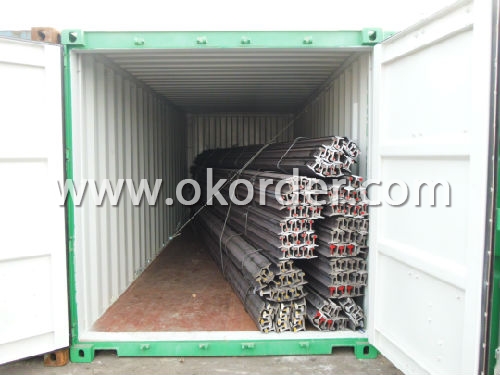
- Q:How are steel rails protected against earthquakes?
- Steel rails are protected against earthquakes by utilizing various engineering techniques such as flexible rail fastening systems, concrete tie sleepers, and ballast. These measures help to reduce the impact of ground shaking on the rails, ensuring their stability and preventing damage during seismic events.
- Q:Why should there be a certain gap in the rail connection?
- Now there are many high-speed railways have adopted the technology of seamless rail, they put the original welding gap between the rails, which no longer had left the gap between the tracks and the train tracks, running is stable, but also greatly reduces the noise between wheel and rail.
- Q:What are the different types of steel rails?
- There are several types of steel rails used in railway tracks, including plain carbon steel rails, low alloy steel rails, heat-treated steel rails, and high-strength steel rails. These different types of steel rails vary in their composition, strength, and durability, allowing them to be used in various applications based on the specific requirements of the railway track.
- Q:How do steel rails contribute to reducing derailments?
- Steel rails contribute to reducing derailments in several ways. Firstly, steel rails provide a strong and durable track structure, ensuring stability and preventing excessive movement of the train. This reduces the chances of derailments caused by track irregularities or instability. Secondly, steel rails have high resistance to wear and tear, minimizing the risk of rail failure due to fatigue or breakage. This enhances the overall safety of the railway system and reduces the likelihood of derailments. Additionally, the smooth surface of steel rails allows for efficient contact between the train's wheels and the track, reducing friction and enhancing the train's stability during operations. Overall, the use of steel rails helps maintain a reliable and secure track infrastructure, thereby contributing significantly to the reduction of derailments.
- Q:Can steel rails be used for monorail systems?
- Yes, steel rails can be used for monorail systems. Steel is a commonly used material for constructing rail tracks due to its strength, durability, and resistance to wear and tear. Monorail systems, which typically have a single rail track, can also be made of steel to provide a stable and safe transportation infrastructure.
- Q:Are steel rails used in tourist train operations?
- Yes, steel rails are commonly used in tourist train operations. The durability and strength of steel make it the preferred material for railway tracks, ensuring safe and efficient travel for tourists.
- Q:What are the environmental implications of using steel rails?
- The use of steel rails in various industries and transportation systems has several environmental implications. Firstly, the extraction and production of steel require significant amounts of energy and natural resources. The mining of iron ore, coal, and limestone, which are essential components of steel production, can lead to habitat destruction, deforestation, and the release of harmful pollutants into the air and water. Additionally, the process of converting these raw materials into steel involves high temperatures and emissions of greenhouse gases, contributing to climate change and air pollution. Secondly, the transportation and installation of steel rails can have negative environmental impacts. The transportation of steel from production facilities to construction sites often involves long-haul trucking or shipping, which can generate greenhouse gas emissions and contribute to air pollution. Moreover, the installation of steel rails may require land clearing, further disrupting ecosystems and potentially leading to habitat loss for wildlife. Furthermore, steel rails can have impacts on local ecosystems and water resources. Runoff from railway tracks may contain pollutants such as heavy metals, oils, and chemicals used for maintenance and lubrication. These pollutants can contaminate nearby soil and water bodies, posing risks to both human health and ecological balance. However, it is important to note that steel rails can also have positive environmental implications. Compared to alternative materials like concrete, steel is highly recyclable. At the end of their lifespan, steel rails can be recycled and repurposed, reducing the need for new steel production and conserving resources. Additionally, the durability and strength of steel rails contribute to the longevity of rail infrastructure, reducing the need for frequent replacements and the associated environmental impacts. In conclusion, the use of steel rails has various environmental implications, including energy-intensive production processes, greenhouse gas emissions, habitat destruction, and potential pollution of water resources. However, the recyclability and longevity of steel rails offer opportunities for mitigating these environmental impacts. As with any material or technology, it is essential to consider a comprehensive life-cycle analysis to understand and minimize the environmental implications of using steel rails.
- Q:What's the difference between a high-speed rail and an ordinary one?
- Not only does the train speed run faster than the train, but the infrastructure (track, signal, communication and catenary) of the train also meets the technical requirements of the speed grade.
- Q:How are steel rails protected against mechanical damage?
- Steel rails are protected against mechanical damage by various methods such as regular maintenance, including grinding and smoothing of the rail surface to remove defects and prevent cracking. Additionally, rail joints are continuously monitored and reinforced to ensure stability and prevent damage. Protective measures like track lubrication and usage of high-quality materials also help reduce wear and tear caused by friction and heavy loads.
- Q:What are the different sizes of steel rails?
- The different sizes of steel rails vary depending on the specific application and usage. Common sizes include 60-pound, 85-pound, 115-pound, and 136-pound rails, with heavier options available for high-speed or heavy freight railways. The size of the rail is determined by its weight per yard, with heavier rails offering greater strength and durability.
1. Manufacturer Overview |
|
|---|---|
| Location | |
| Year Established | |
| Annual Output Value | |
| Main Markets | |
| Company Certifications | |
2. Manufacturer Certificates |
|
|---|---|
| a) Certification Name | |
| Range | |
| Reference | |
| Validity Period | |
3. Manufacturer Capability |
|
|---|---|
| a)Trade Capacity | |
| Nearest Port | |
| Export Percentage | |
| No.of Employees in Trade Department | |
| Language Spoken: | |
| b)Factory Information | |
| Factory Size: | |
| No. of Production Lines | |
| Contract Manufacturing | |
| Product Price Range | |
Send your message to us
Steel Light Rail wfith High Quality for Construction
- Loading Port:
- China main port
- Payment Terms:
- TT or LC
- Min Order Qty:
- 25 m.t.
- Supply Capability:
- 100000 m.t./month
OKorder Service Pledge
OKorder Financial Service
Similar products
New products
Hot products
Hot Searches
Related keywords
